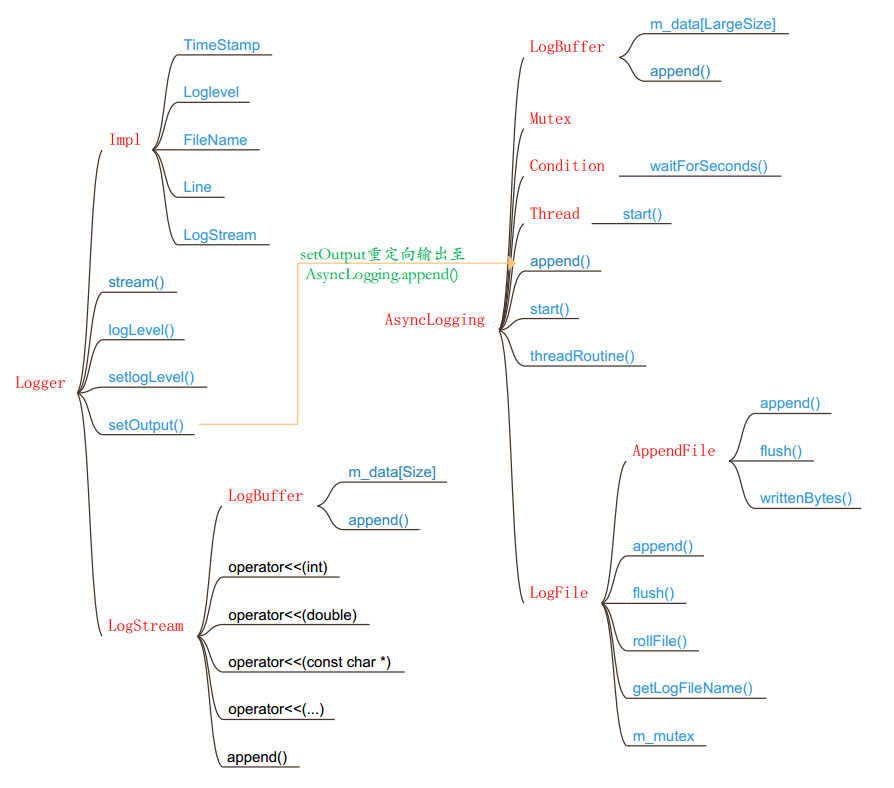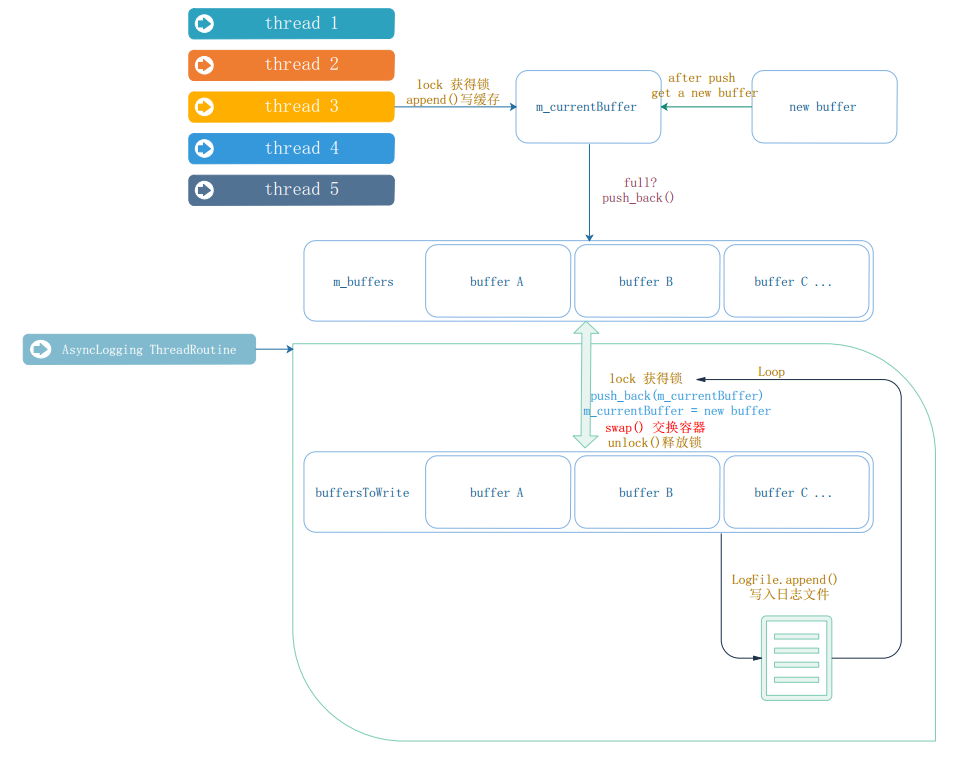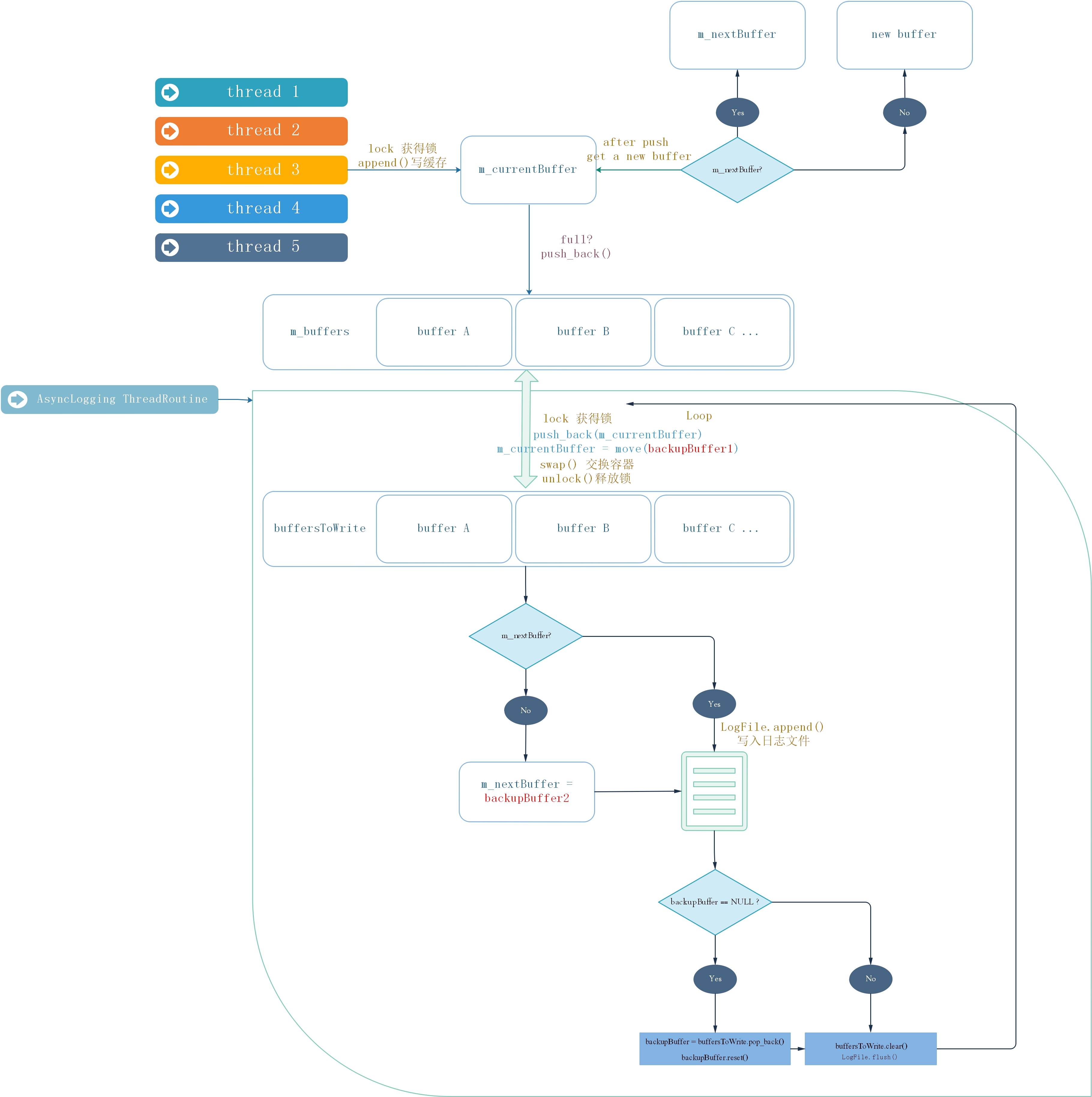一个轻巧高效的多线程c++stream风格异步日志(二)
一个轻巧高效的多线程c++stream风格异步日志(二)
前言
本文紧接上一篇文章: 介绍上文中的一条条日志是如何异步导入本地文件的.
首先会简单介绍下LogFile类,之后会具体讲解下AsyncLogging中的双缓冲机制.
整个日志模块的结构图,

LogFile类
LogFile日志文件类 完成日志文件的管理工作.
rollFile() :滚动文件 当日志超过m_rollSize大小时会滚动一个新的日志文件出来.
getLogFileName() :用与滚动日志时,给日志文件取名,以滚动时间作为后缀.
m_mutex :用于append()数据时,给文件上锁.
append() :黏入日志.
flush() :冲刷缓冲.
LogFile 有一个AppendFIle类,它是最终用于操作本地文件的类.
append() : 里面会调用系统函数fwrite()写入本地文件.
flush() : 冲刷缓冲.
writtenBytes() : 获取已写字节数.

AsyncLogging类
AsyncLogging异步日志类, 完成日志的异步写入工作.
介绍它的接口前,先描述下它的工作逻辑.
AsyncLogging 有以下述几类缓存.
m_currentBuffer : 指向当前接收其他线程append过来的日志的缓存.
m_buffers : 用于存放当前已写满或过了冲刷周期的日志缓存的指针容器.
m_nextBuffer : 指向当m_currentBuffer满后用于替代m_currentBuffer的缓存.
backupBuffer1 : 备用缓存.
backupBuffer2 : 备用缓存.
buffersToWrite : 和m_buffers通过交换swap()后append()到LogFile的指针容器.
AsyncLogging 使用的双缓冲机制 有两个缓存容器 : m_buffers 、buffersToWrite 交替使用 . 一下我们简称为 A 和 B .
A 用于接收 其他线程 append() 进来的日志.
B 用于将目前已接受的缓存 写入 日志文件. 当B写完时 , clean() B , 交换A,B,如此往复.
优点 : 新建的日志不必等待磁盘操作,也避免了每条新日志都触发日志线程,而是将多条日志拼程一个大的buffer 传送给日志线程写入文件. 相当于批处理, 减少线程唤醒频率 ,降低开销。
另外 ,为了及时将 日志消息写入文件, 即是 buffer A 中还没有push进来日志 也会每三秒 执行一次上述的写入操作.

AsyncLogging使用一个更大的LogBuffer来保存一条条Logger传送过来的日志.
Mutex :用来控制多线程的写入.
Condition : 用来等待缓冲区中的数据.
Thread : 使用一个线程处理缓存的交换,以及日志的写入.

AsyncLogging实现
下面会给出AsyncLogging的简单实现.
实际上还有几个备用缓存,这里没有加上去,以便于理解程序; 备用缓存主要是为了减少反复new 操作带来的系统开销,
#ifndef _ASYNC_LOGGING_HH
#define _ASYNC_LOGGING_HH
#include "MutexLock.hh"
#include "Thread.hh"
#include "LogStream.hh"
#include "ptr_vector.hh"
#include "Condition.hh"
#include <string>
class AsyncLogging
{
public:
AsyncLogging(const std::string filePath, off_t rollSize, int flushInterval = 3);
~AsyncLogging();
void start(){
m_isRunning = true;
m_thread.start();
}
void stop(){
m_isRunning = false;
m_cond.notify();
}
void append(const char *logline, int len);
private:
AsyncLogging(const AsyncLogging&);
AsyncLogging& operator=(const AsyncLogging&);
void threadRoutine();
typedef LogBuffer<kLargeBuffer> Buffer;
typedef oneself::ptr_vector<Buffer> BufferVector;
typedef oneself::auto_ptr<Buffer> BufferPtr;
const int m_flushInterval;
bool m_isRunning;
off_t m_rollSize;
std::string m_filePath;
Thread m_thread;
MutexLock m_mutex;
Condition m_cond;
BufferPtr m_currentBuffer;
BufferVector m_buffers;
};
#endif
//AsyncLogging.cpp
#include "AsyncLogging.hh"
#include "LogFile.hh"
#include <assert.h>
#include <stdio.h>
AsyncLogging::AsyncLogging(const std::string filePath, off_t rollSize, int flushInterval)
:m_filePath(filePath),
m_rollSize(2048),
m_flushInterval(flushInterval),
m_isRunning(false),
m_thread(std::bind(&AsyncLogging::threadRoutine, this)),
m_mutex(),
m_cond(m_mutex),
m_currentBuffer(new Buffer),
m_buffers()
{
}
AsyncLogging::~AsyncLogging(){
if(m_isRunning) stop();
}
void AsyncLogging::append(const char* logline, int len){
MutexLockGuard lock(m_mutex);
if(m_currentBuffer->avail() > len){
m_currentBuffer->append(logline, len);
}
else{
m_buffers.push_back(m_currentBuffer.release());
m_currentBuffer.reset(new Buffer);
m_currentBuffer->append(logline, len);
m_cond.notify();
}
}
void AsyncLogging::threadRoutine(){
assert(m_isRunning == true);
LogFile output(m_filePath, m_rollSize, false);
BufferVector buffersToWrite;
buffersToWrite.reserve(8);
while(m_isRunning){
assert(buffersToWrite.empty());
{
MutexLockGuard lock(m_mutex);
if(m_buffers.empty()){
m_cond.waitForSeconds(m_flushInterval);
}
m_buffers.push_back(m_currentBuffer.release());
m_currentBuffer.reset(new Buffer);
m_buffers.swap(buffersToWrite);
}
assert(!buffersToWrite.empty());
for(size_t i = 0; i < buffersToWrite.size(); ++i){
output.append(buffersToWrite[i]->data(), buffersToWrite[i]->length());
}
buffersToWrite.clear();
output.flush();
}
output.flush();
}
增加备用缓存
增加备用缓存优化上面程序,上面程序一共在两个地方执行了new操作.
1.m_currentBuffer 填满时,需要把它填进容器的时候.
2.到时间了需要把m_currentBuffer里面的内容写入本地文件时,会把它当前的内容移出来,这时候需要new一个新缓存来给m_currentBuffer.
于是我们准备一个m_nextBuffer来做m_currentBuffer的备用缓存.同时在线程中增加两个backupBuffer 给m_nextBuffer 当备用缓存;当日志量大到不够用的时候, 再考虑用new 操作来动态添加缓存。

#ifndef _ASYNC_LOGGING_HH
#define _ASYNC_LOGGING_HH
#include "MutexLock.hh"
#include "Thread.hh"
#include "LogStream.hh"
#include "ptr_vector.hh"
#include "Condition.hh"
#include <memory>
#include <string>
class AsyncLogging
{
public:
AsyncLogging(const std::string filePath, off_t rollSize, int flushInterval = 3);
~AsyncLogging();
void start(){
m_isRunning = true;
m_thread.start();
}
void stop(){
m_isRunning = false;
m_cond.notify();
}
void append(const char *logline, int len);
private:
AsyncLogging(const AsyncLogging&);
AsyncLogging& operator=(const AsyncLogging&);
void threadRoutine();
typedef LogBuffer<kLargeBuffer> Buffer;
typedef myself::ptr_vector<Buffer> BufferVector;
typedef std::unique_ptr<Buffer> BufferPtr;
const int m_flushInterval;
bool m_isRunning;
off_t m_rollSize;
std::string m_filePath;
Thread m_thread;
MutexLock m_mutex;
Condition m_cond;
BufferPtr m_currentBuffer;
BufferPtr m_nextBuffer;
BufferVector m_buffers;
};
#endif
//AsynvLogging.cpp
#include "AsyncLogging.hh"
#include "LogFile.hh"
#include <assert.h>
#include <stdio.h>
AsyncLogging::AsyncLogging(const std::string filePath, off_t rollSize, int flushInterval)
:m_filePath(filePath),
m_rollSize(rollSize),
m_flushInterval(flushInterval),
m_isRunning(false),
m_thread(std::bind(&AsyncLogging::threadRoutine, this)),
m_mutex(),
m_cond(m_mutex),
m_currentBuffer(new Buffer),
m_nextBuffer(new Buffer),
m_buffers()
{
}
AsyncLogging::~AsyncLogging(){
if(m_isRunning) stop();
}
void AsyncLogging::append(const char* logline, int len){
MutexLockGuard lock(m_mutex);
if(m_currentBuffer->avail() > len){
m_currentBuffer->append(logline, len);
}
else{
m_buffers.push_back(m_currentBuffer.release());
if(m_nextBuffer){
m_currentBuffer = std::move(m_nextBuffer);
}
else{
m_currentBuffer.reset(new Buffer);
}
m_currentBuffer->append(logline, len);
m_cond.notify();
}
}
void AsyncLogging::threadRoutine(){
assert(m_isRunning == true);
LogFile output(m_filePath, m_rollSize, false);
BufferPtr backupBuffer1(new Buffer);
BufferPtr backupBuffer2(new Buffer);
BufferVector buffersToWrite;
buffersToWrite.reserve(8);
while(m_isRunning){
assert(buffersToWrite.empty());
{
MutexLockGuard lock(m_mutex);
if(m_buffers.empty()){
m_cond.waitForSeconds(m_flushInterval);
}
m_buffers.push_back(m_currentBuffer.release());
m_currentBuffer = std::move(backupBuffer1);
m_buffers.swap(buffersToWrite);
if(!m_nextBuffer)
m_nextBuffer = std::move(backupBuffer2);
}
assert(!buffersToWrite.empty());
for(size_t i = 0; i < buffersToWrite.size(); ++i){
output.append(buffersToWrite[i]->data(), buffersToWrite[i]->length());
}
if(buffersToWrite.size() > 2)
{
// drop non-bzero-ed buffers, avoid trashing
buffersToWrite.resize(2);
}
if(!backupBuffer1)
{
assert(!buffersToWrite.empty());
backupBuffer1 = std::move(buffersToWrite.pop_back());
backupBuffer1->reset();
}
if(!backupBuffer2)
{
assert(!buffersToWrite.empty());
backupBuffer2 = std::move(buffersToWrite.pop_back());
backupBuffer2->reset();
}
buffersToWrite.clear();
output.flush();
}
output.flush();
}
结语
本文主要介绍了muduo中AsyncLogging类的实现,其中的双缓存机制.
LogFile类及AppendFIle类 分别是日志文件管理类和本地文件的基本操作类. 不难理解,感兴趣的话可以看看muduo的源码,本文不再往下写了,如果想要全部源码可以留言。
最新源码:
https://github.com/BethlyRoseDaisley/SimpleMuduo/tree/master/AsyncLogging
一个轻巧高效的多线程c++stream风格异步日志(二)的更多相关文章
- 一个轻巧高效的多线程c++stream风格异步日志(一)
一个轻巧高效的多线程c++stream风格异步日志 一个轻巧高效的多线程c++stream风格异步日志 前言 功能需求 性能需求 Logger实现 LogStream类 Logger类 LogStre ...
- WaitForSingleObject与WaitForMultipleObjects用法详解(好用,而且进入一个非常高效沉睡状态,只占用极少的CPU时间片)
在多线程下面,有时候会希望等待某一线程完成了再继续做其他事情,要实现这个目的,可以使用Windows API函数WaitForSingleObject,或者WaitForMultipleObjects ...
- [转]一个简单的Linux多线程例子 带你洞悉互斥量 信号量 条件变量编程
一个简单的Linux多线程例子 带你洞悉互斥量 信号量 条件变量编程 希望此文能给初学多线程编程的朋友带来帮助,也希望牛人多多指出错误. 另外感谢以下链接的作者给予,给我的学习带来了很大帮助 http ...
- (转)log4j(四)——如何控制不同风格的日志信息的输出?
一:测试环境与log4j(一)——为什么要使用log4j?一样,这里不再重述 1 老规矩,先来个栗子,然后再聊聊感受 import org.apache.log4j.*; //by godtrue p ...
- python 多进程/多线程/协程 同步异步
这篇主要是对概念的理解: 1.异步和多线程区别:二者不是一个同等关系,异步是最终目的,多线程只是我们实现异步的一种手段.异步是当一个调用请求发送给被调用者,而调用者不用等待其结果的返回而可以做其它的事 ...
- log4j(四)——如何控制不同风格的日志信息的输出?
一:测试环境与log4j(一)——为什么要使用log4j?一样,这里不再重述 二:老规矩,先来个栗子,然后再聊聊感受 import org.apache.log4j.*; //by godtrue p ...
- Java8新特性 Stream流式思想(二)
如何获取Stream流刚开始写博客,有一些不到位的地方,还请各位论坛大佬见谅,谢谢! package cn.com.zq.demo01.Stream.test01.Stream; import org ...
- 写一个Windows上的守护进程(4)日志其余
写一个Windows上的守护进程(4)日志其余 这次把和日志相关的其他东西一并说了. 一.vaformat C++日志接口通常有两种形式:流输入形式,printf形式. 我采用printf形式,因为流 ...
- Prism for WPF 搭建一个简单的模块化开发框架(四)异步调用WCF服务、WCF消息头添加安全验证Token
原文:Prism for WPF 搭建一个简单的模块化开发框架(四)异步调用WCF服务.WCF消息头添加安全验证Token 为什么选择wcf? 因为好像wcf和wpf就是哥俩,,, 为什么选择异步 ...
随机推荐
- adb logcat介绍
logcat命令语法: [adb] logcat [<option>] ... [<filter-spec>] ... adb logcat -c 清除所有以前的日志 adb ...
- ubuntu,centor 安装apache bench
ab全称为:apache bench. 是apache自带的压力测试工具.ab非常实用,它不仅可以对apache服务器进行网站访问压力测试,也可以对或其它类型的服务器进行压力测试.比如nginx.to ...
- Python3.x文件处理详解
Python3.x文件处理详解 作者:尹正杰 版权声明:原创作品,谢绝转载!否则将追究法律责任. 任何一门语言都有其特有的操作文件的方式,Python2.x版本有两种操作文件的方式,没错就是open函 ...
- [转载]Markdown——入门指南
http://www.jianshu.com/p/1e402922ee32/ 转载请注明原作者,如果你觉得这篇文章对你有帮助或启发,也可以来请我喝咖啡. 导语: Markdown 是一种轻量级的「标记 ...
- oracle用户密码过期!the password has expired
Oracle提示错误消息ORA-28001: the password has expired,是由于Oracle11G的新特性所致, Oracle11G创建用户时缺省密码过期限制是180天(即6个月 ...
- nc用法【转】
linux nc命令使用详解 功能说明:功能强大的网络工具 语 法:nc [-hlnruz][-g<网关...>][-G<指向器数目>][-i<延迟秒数>][-o& ...
- MySQL用户密码过期登陆报错ERROR 1820 (HY000): You must reset your password using ALTER USER statement before executing this statement.
今天接到主从复制失败告警,查看MySQL,发现MySQL能够登陆但是执行命令报错, ERROR 1820 (HY000): You must reset your password using ALT ...
- 005_ss-link.info的ping探测工具
用小工具ping.py测试距离您最快的节点 #!/usr/bin/env python # coding: utf-8 """ A pure python ping im ...
- 关于 VS 2010 和 VS 2013 的警告 LNK4042
由于我最近调整了一下 Jimi 的文件结构,导致出现了一个 LNK4042 的 warning,我并没有很重视,这个 warning 导致出现了一些错误. 我调试了几个小时,一开始并没有想到是这个 w ...
- centos6.5环境DNS-本地DNS主从服务器bind的搭建
centos6.5环境DNS-本地DNS主从服务器bind的搭建 在上一篇博客中我已经搭建好了一个本地DNS服务器,能够实现正向反向解析,那么我们只需要加入一台从DNS服务器即可完成,我们来开始配置主 ...
